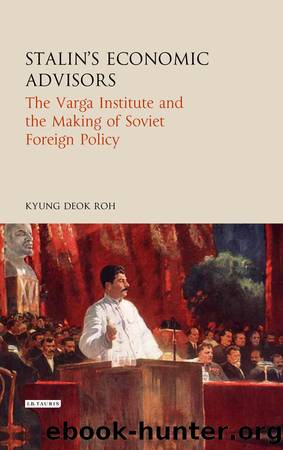Stalin's Economic Advisors by Kyung Deok Roh

Author:Kyung Deok Roh [Roh, Kyung Deok]
Language: eng
Format: epub
Tags: Business & Economics, Economic History
ISBN: 9781786733177
Google: uROJDwAAQBAJ
Publisher: Bloomsbury Publishing
Published: 2018-02-09T22:30:21+00:00
Subsequent Development in the mid-1930s
Vargaâs new conceptualisation of the capitalist state provided him with a theoretical space in which he could accurately assess its potentials to manage and overcome the crisis and anticipate that the current phase would be soon turned into a kind of new revival. Already, at the end of New Phenomena, Varga talked about some âfavourableâ signs in Western economy. According to him, summer 1932 was the lowest point of the crisis and now â in late 1933 â it was certainly in an upward swing. Varga discussed the reasons in a chapter titled âDynamics of the Crisisâ.
Just as in the earlier part of the text on the origins and development of the crisis, the chapter displayed the tension between the generalist tendency of Marxian economics and the concrete and historical-oriented explanations. Initially, Varga put up front the âoldâ Marxist style of discussions that looked for the causes at a highly abstract theoretical level. He declared that the general cause of the improvement was fundamentally because of âthe immanent laws of capitalismâs movementâ, which, regardless of historical context and the will of political-economic actors, has an automatic recovery function at the bottom of economic cycles. Relying on Hilferdingâs insights on the cycle of capitalist economy, Varga showed how the law was applied to the current crisis as follows: during the long period of the crisis, the surplus of the finished commodities in light industries (Division II) was finally absorbed, which enabled Division II to place some, albeit not great, orders to factories (Division I), who produced the means of production. Now, Division I was able to be in a position to use raw materials that had been abandoned for the previous four years and start to manufacture industrial goods, which was expressed by some growth in various production statistics.35
In Vargaâs view, this growth could be probably seen as a green light on the capitalist economy, but was still not sufficient. The renewal of fixed capital was too small in quantity to elevate the whole economy to a normal cycle expansion. Factories in Division I were now just consuming the previously unused raw materials and did not venture to make much new investment. Capitalismâs struggles to get back to a normal expansion phase were because it was situated within the framework of the general crisis. As a result, according to Varga, the current phase of capitalism defied the normal procedure of business cycle: it was a depression as the stage next to crisis but it did not represent a prelude to prosperity. In other words, it was a âdepression of a special kind (depressiia osobogo roda)â.36
The inner mechanism of capitalism was effective enough to overcome the lowest point of the crisis, to bring about the transition to a depression, and in some countries to create a limited revival; but it does not prove to be effective enough to produce a real boom, a prosperity phase ⦠The current âdepressionâ in no way represents one in a normal/usual sense.
Download
This site does not store any files on its server. We only index and link to content provided by other sites. Please contact the content providers to delete copyright contents if any and email us, we'll remove relevant links or contents immediately.
The Secret History by Donna Tartt(18843)
The Social Justice Warrior Handbook by Lisa De Pasquale(12141)
Thirteen Reasons Why by Jay Asher(8792)
This Is How You Lose Her by Junot Diaz(6793)
Weapons of Math Destruction by Cathy O'Neil(6142)
Zero to One by Peter Thiel(5685)
Beartown by Fredrik Backman(5594)
The Myth of the Strong Leader by Archie Brown(5424)
The Fire Next Time by James Baldwin(5248)
How Democracies Die by Steven Levitsky & Daniel Ziblatt(5127)
Promise Me, Dad by Joe Biden(5087)
Stone's Rules by Roger Stone(5026)
A Higher Loyalty: Truth, Lies, and Leadership by James Comey(4842)
100 Deadly Skills by Clint Emerson(4840)
Rise and Kill First by Ronen Bergman(4701)
Secrecy World by Jake Bernstein(4643)
The David Icke Guide to the Global Conspiracy (and how to end it) by David Icke(4624)
The Farm by Tom Rob Smith(4434)
The Doomsday Machine by Daniel Ellsberg(4415)
